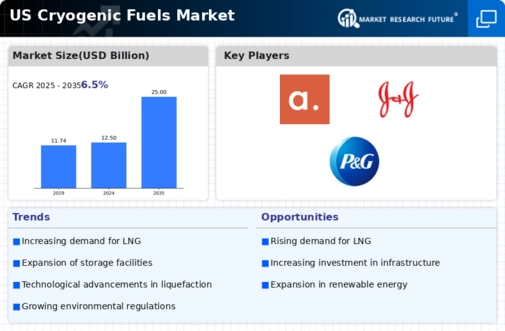Rising Demand for Clean Energy Solutions
The increasing emphasis on clean energy solutions is a pivotal driver for the cryogenic fuels market. As the U.S. transitions towards sustainable energy sources, the demand for low-emission fuels is surging. Cryogenic fuels, such as liquid hydrogen and liquefied natural gas (LNG), are gaining traction due to their potential to reduce greenhouse gas emissions. In 2025, the U.S. aims to achieve a 50% reduction in emissions by 2030, which could further propel the adoption of cryogenic fuels. The cryogenic fuels market is likely to benefit from this shift, as industries seek alternatives to traditional fossil fuels. Furthermore, the growing awareness of climate change impacts is prompting investments in research and development of cryogenic technologies, potentially enhancing market growth.
Government Incentives for Alternative Fuels
Government incentives aimed at promoting alternative fuels are playing a crucial role in shaping the cryogenic fuels market. The U.S. government has implemented various tax credits and grants to encourage the adoption of cleaner fuels, including cryogenic options. For instance, the Alternative Fuel Tax Credit provides financial benefits to companies investing in LNG infrastructure. This initiative is expected to increase the market share of cryogenic fuels by approximately 10% over the next five years. Additionally, state-level programs are also emerging, offering support for research and development in cryogenic technologies. Such incentives are likely to bolster the cryogenic fuels market, making it an attractive option for businesses seeking to comply with environmental regulations.
Technological Innovations in Cryogenic Storage
Technological innovations in cryogenic storage systems are enhancing the viability of cryogenic fuels, thereby impacting the market positively. Advances in insulation materials and storage tank designs are improving the efficiency and safety of cryogenic fuel storage. The U.S. Department of Energy has reported a 15% increase in storage efficiency due to these innovations, which could lead to lower operational costs for businesses in the cryogenic fuels market. Furthermore, the development of advanced liquefaction processes is enabling the production of cryogenic fuels at a lower cost, making them more accessible to various industries. As these technologies continue to evolve, they are likely to attract investments and stimulate growth within the cryogenic fuels market.
Growing Investment in Renewable Energy Projects
The growing investment in renewable energy projects is a significant driver for the cryogenic fuels market. As the U.S. aims to diversify its energy portfolio, investments in renewable sources such as wind and solar are increasing. This shift is creating opportunities for integrating cryogenic fuels into energy systems, particularly in energy storage applications. The cryogenic fuels market is likely to benefit from the projected $100 billion investment in renewable energy infrastructure by 2030. This influx of capital could facilitate the development of hybrid systems that utilize cryogenic fuels alongside renewable sources, enhancing energy efficiency and reliability. Consequently, the market may witness a surge in demand as stakeholders seek innovative solutions to meet energy needs.
Expansion of Aerospace and Transportation Sectors
The aerospace and transportation sectors are experiencing significant growth, which is likely to drive the cryogenic fuels market. The U.S. aerospace industry, valued at approximately $250 billion in 2025, is increasingly utilizing cryogenic fuels for rocket propulsion and other applications. The demand for efficient and powerful fuels in space exploration and commercial aviation is pushing manufacturers to explore cryogenic options. Additionally, the transportation sector is gradually adopting LNG as a cleaner alternative to diesel, with projections indicating a 20% increase in LNG usage by 2027. This trend suggests that the cryogenic fuels market will see heightened activity as companies strive to meet regulatory standards and consumer preferences for cleaner fuels.














Leave a Comment